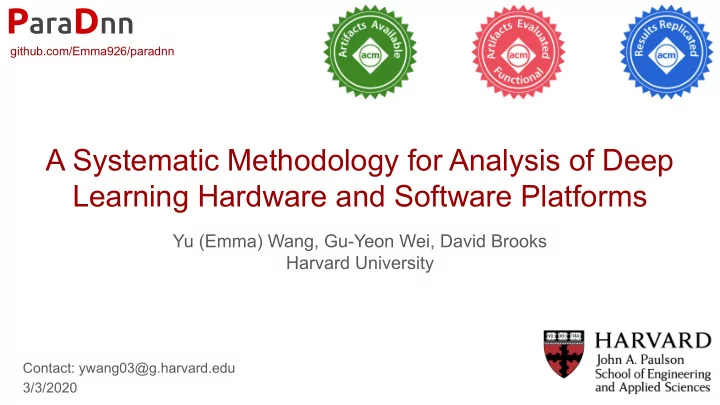

P ara D nn github.com/Emma926/paradnn A Systematic Methodology for Analysis of Deep Learning Hardware and Software Platforms Yu (Emma) Wang, Gu-Yeon Wei, David Brooks Harvard University Contact: ywang03@g.harvard.edu 3/3/2020
Acknowledgement Frank Chen, Glenn Holloway, Dan Janni, Peter Mattson, Lifeng Nai, David Patterson, Francesco Pontiggia, Parthasarathy Ranganathan, Vijay Reddi, Brennan Saeta, Zak Stone, Anitha Vijayakumar, Shibo Wang, Qiumin Xu, Doe Hyun Yoon, Cliff Young
Challenges with ML Benchmarking ● Diversity in deep learning models used Problem Domains, Models, Datasets ○ ● Pace of field State-of-the-art models evolve every few months ○ ● Varying evaluation metrics Accuracy, Time to train, Latency of inference ○ ● Multi-disciplinary field Algorithms, Systems, Hardware, ML Software Stacks ○
State of the art: MLPerf 0.6 Area Benchmark Dataset Model Reference Implementation Vision Image classification ImageNet ResNet-50 TensorFlow Object detection COCO 2017 Mask R-CNN Pytorch Object detection COCO 2017 SSD-ResNet34 Pytorch Language/ Translation WMT Eng-Germ Transformer TensorFlow Audio Speech recognition GNMT PyTorch WMT Eng-Germ Commerce Recommendation MovieLens-20M NCF PyTorch Action Reinforcement Learning Go Mini-go TensorFlow
State of the art: MLPerf 0.6 Area Benchmark Dataset Model Reference Implementation Vision Image classification ImageNet ResNet-50 TensorFlow Object detection COCO 2017 Mask R-CNN Pytorch Object detection COCO 2017 SSD-ResNet34 Pytorch Language/ Translation WMT Eng-Germ Transformer TensorFlow Audio Speech recognition GNMT PyTorch WMT Eng-Germ Commerce Recommendation MovieLens-20M NCF PyTorch Action Reinforcement Learning Go Mini-go TensorFlow
Our Methodology P ara D nn
Our Methodology P ara D nn
ParaDnn vs MLPerf P ara D nn - Avoid drawing conclusions based on - Good for studying accuracy or several arbitrary models convergence with real datasets - Generate thousands of parameterized , - Represent the specific models some end-to-end models people care about - Prepare hardware designs for future models - Complement the use of existing real-world models, i.e. MLPerf
ParaDnn Canonical Models Fully Connected (FC) # of Layers Input # of Nodes # of Nodes Output CNNs: Residual, Bottleneck # of Res/Bottleneck x 4 Input FC Layer Output Blocks (filter size) RNNs: RNN, LSTM, GRU # of Layers Input RNN or LSTM or GRU cell (size) RNN or LSTM or GRU cell Output
Models
Models - ParaDnn covers a larger range than the real models - from 10k to ~1 billion parameters
Analysis Enabled by ParaDnn - Roofline analysis of TPU v2 - Homogenous Platform Comparison: TPU v2 vs v3 - Heterogeneous Platform Comparison: TPU vs GPU
The Roofline Model David Brooks, Gu-Yeon Wei 13
The Roofline Model Peak FLOPS David Brooks, Gu-Yeon Wei 14
The Roofline Model Peak FLOPS Memory Bandwidth David Brooks, Gu-Yeon Wei 15
The Roofline Model compute-intensive David Brooks, Gu-Yeon Wei 16
The Roofline Model memory-intensive compute-intensive David Brooks, Gu-Yeon Wei 17
Transformer David Brooks, Gu-Yeon Wei 18
FC Models ParaDnn sweeps a large range of models, from memory-bound to compute-bound. David Brooks, Gu-Yeon Wei 19
FC Models Compute-bound David Brooks, Gu-Yeon Wei 20
FC Models Memory-bound David Brooks, Gu-Yeon Wei 21
TPU v2 vs v3? 22
How to upgrade to TPU v3? TPU v2 23
How to upgrade to TPU v3? TPU v3 (FLOPS ) TPU v2 24
How to upgrade to TPU v3? TPU v3 (FLOPS ) TPU v2 TPU v3 (Mem BW ) 25
How to upgrade to TPU v3? TPU v3 (FLOPS Mem BW ) TPU v3 (FLOPS ) TPU v2 TPU v3 (Mem BW ) 26
How to upgrade to TPU v3? TPU v3 (FLOPS Mem BW ) ? x TPU v2 ? x 27
Architecture of TPU v2 vs v3 180 TFLOPS / Board 420 TFLOPS / Board 28 Figure is from https://cloud.google.com/tpu/docs/system-architecture
Google’s Choice of TPU v3 TPU v3 2.3 x TPU v2 ? x 29
TPU v3 vs v2: FC Operation Breakdown 30
TPU v3 vs v2: FC Operation Breakdown Compute-bound: 2.3x speedup 31
TPU v3 vs v2: FC Operation Breakdown Memory-bound: 1.5x speedup 32
TPU v3 vs v2: FC Operation Breakdown Memory-bound, but benefit from 2x memory capacity: 3x speedup 33
Google’s Choice of TPU v3 TPU v3 2.3 x TPU v2 1.5 x 34
TPU v3 vs v2: FC Operation Breakdown ParaDnn provides diverse set of operations, and shows different operations are sensitive to different system component upgrades. 35
TPU vs GPU?
Hardware Platforms 37
Hardware Platforms 300 GB/s per core 38
FC and CNN FC W A FC FC Gradient G Weighted Sum
FC and CNN FC CNN Fewer Weights W W Conv A FC A Larger Conv ops FC Conv Gradient Gradient G G Weighted Weighted Sum Sum
Hardware Platforms 300 GB/s per core 41
FC TPU/GPU Speedup colored with Batch Size 9 0.35 42
FC TPU/GPU Speedup colored with Batch Size 9 TPU is better GPU is better 0.35 43
FC TPU/GPU Speedup colored with Batch Size 9 TPU is better GPU is better 0.35 44
FC TPU/GPU Speedup colored with Node Size 9 More nodes More weights More memory-bound 45
Hardware Platforms 1.44x 300 GB/s per core 46
CNN TPU/GPU Speedup colored with Batch Size 47
CNN TPU/GPU Speedup colored with Batch Size - Up to 6x speedup - TPU architecture and software is highly optimized for CNNs 48
CNN TPU/GPU Speedup colored with Batch Size - All models runs faster on TPU. - Larger batch sizes lead to higher speedups. 49
CNN TPU/GPU Speedup colored with Filters - More filters have higher speedup lower bounds 50
Conclusion - Parameterized methodology: ParaDnn + a set of analysis methods - Single platform analysis: TPU v2 - Homogenous platform comparison: TPU v2 vs v3 - Heterogeneous platform comparison: TPU vs GPU
Limitations of this Work - Does not include: - Inference - Multi-node system: multi-GPU, or TPU pods - Accuracy, convergence - Cloud overhead - Tractability - Limit the range of hyperparameters and datasets - Small batch sizes (<16) and large batch sizes (> 2k) are not studied - Synthetic datasets do not include data infeed overhead - Iterations of TPU loop is 100. Larger numbers can slightly increase the performance.
P ara D nn Available: github.com/Emma926/paradnn Questions?
Recommend
More recommend